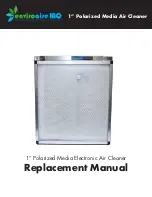
6
suitable for the refrigerant used. Leak detection
equipment shall be set at a percentage of the
LFL of the refrigerant and shall be calibrated to
the refrigerant employed and the appropriate
percentage of gas (25 % maximum) is
confirmed. Leak detection fluids are suitable for
use with most refrigerants but the use of
detergents containing chlorine shall be avoided
as the chlorine may react with the refrigerant
and corrode the copper pipe-work.
If a leak is suspected, all naked flames shall
be removed or extinguished.
If a leakage of refrigerant is found which
requires brazing, all of the refrigerant shall be
recovered from the system, or isolated (by
means of shut off valves) in a part of the
system
remote from the leak. Oxygen free nitrogen
(OFN) shall then be purged through the
system both before and during the brazing
process.
15. Removal and evacuation
When breaking into the refrigerant circuit to
make repairs or for any other purpose
conventional procedures shall be used.
However, it is important that best practice is
followed since flammability is a consideration.
The following procedure shall be adhered to:
remove refrigerant;
purge the circuit with inert gas;
evacuate;
purge again with inert gas;
open the circuit by cutting or brazing.
The refrigerant charge shall be recovered into
the correct recovery cylinders. The system
shall be flushed with OFN to render the
unit safe. This process may need to be
repeated several times. Compressed air or
oxygen shall not be used for this task. Flushing
shall be achieved by breaking the vacuum in
the system with OFN and continuing to fill until
the working pressure is achieved, then venting
to atmosphere, and finally pulling down to a
vacuum. This process shall be repeated until no
refrigerant is within the system. When the final
OFN charge is used, the system shall be
vented down to atmospheric pressure to enable
work to take place. This operation is absolutely
vital if brazing operations on the pipe-work are
to take place.
Ensure that the outlet for the vacuum pump is
not close to any ignition sources and there is
ventilation available.
16. Charging procedures
In addition to conventional charging procedures,
the following requirements shall be followed:
Ensure that contamination of different
refrigerants does not occur when using
charging equipment. Hoses or lines shall be as
short as possible to minimize the amount of
refrigerant contained in them.
Cylinders shall be kept upright.
Ensure that the refrigeration system is
earthed prior to charging the system with
refrigerant.
Label the system when charging is complete
(if not already).
Extreme care shall be taken not to overfill
the refrigeration system.
Prior to recharging the system it shall be
pressure tested with OFN. The system shall be
leak tested on completion of charging but prior
to commissioning. A follow up leak test shall be
carried out prior to leaving the site.
17. Decommissioning
Before carrying out this procedure, it is
essential that the technician is completely
familiar with the equipment and all its detail. It is
recommended good practice that all
refrigerants are recovered safely. Prior to the
task being carried out, an oil and refrigerant
sample shall be taken.
In case analysis is required prior to re-use of
reclaimed refrigerant. It is essential that
electrical power is available before the task is
commenced.
a) Become familiar with the equipment and its
operation.
b) Isolate system electrically.
c) Before attempting the procedure ensure that:
Summary of Contents for MSMTAU-09HRFN8-QRD6GW
Page 1: ...Ultimate Comfort 3D Inverter Series Service Manual 2017 R32...
Page 12: ...10 For MSMTAU 09HRFN8 QRD6GW MSMTAU 12HRFN8 QRD6GW...
Page 23: ...21 8 Wiring Diagram 8 1 Indoor Unit MSMTAU 09HRFN8 QRD6GW MSMTAU 12HRFN8 QRD6GW...
Page 24: ...22 8 2 Outdoor Unit MOB01 09HFN8 QRD6GW MOB01 12HFN8 QRD6GW...









































